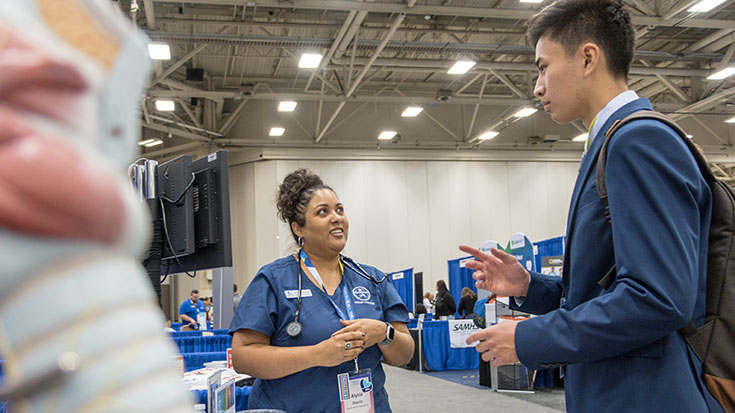
The need for respiratory therapists (RTs) is evident by the number of health care leaders navigating competitive respiratory care job markets1 and RT departments working short staffed.2 The respiratory care profession faces staffing demand challenges which require short- and long-term solutions. While health care leaders address the current staffing needs with travel RT positions, increased pay, and retention plans, we also have a responsibility to plan for the future. As a result, recruiting future respiratory therapists has become a primary focus across the profession.
Recent updates in the Occupational Outlook Handbook demonstrate promising growth in the respiratory care profession. According to the Bureau of Labor Statistics, the job outlook for RTs is expected to grow 23% by 2030.3 This projection is much faster than the average for all other occupations, including a projected 12% growth, on average, for healthcare diagnosing or treating practitioners. The number of RT jobs is projected to grow by 31,100 positions through 2030, and an estimated 10,100 openings for RTs will be available each year through 2030. According to the Commission on Accreditation for Respiratory Care (CoARC), 415 of the 443 CoARC accredited programs are listed as entry into the profession.4 These entry-level programs will be a primary source for meeting the demand of the projected positions. Board exam pass rates suggest the number of exam takers currently falls far below the projected annual need for RTs filling open positions. In 2020, only 5,894 Certified Respiratory Therapist (CRT) credentials were awarded,5 which was down 242 CRT credentials from 2019.6
We must seriously consider the answer to the question, “How can we effectively recruit for respiratory care programs?” Foundational marketing strategies suggest that the answer may very well lie in a better understanding of the targeted audience. In other words, who is best fit for a future in respiratory care?
Who are we looking for?
We must first start by clearly defining our target audience. A logical place to start is an individual with an interest for working in health care or another helping profession. Generally, people looking for a career which allows them to be active, to work independently and in team situations, to think critically, and to solve problems will be a good fit for respiratory care. In my experience as an RT program director, individuals with kinesthetic and/or visual learning preferences are often successful in the curriculum. Traits that leaders attribute to successful RTs include confidence, self-motivation, adaptability, willingness to learn, and a cheerful disposition.7 Given the high acuity patient management attributed to many respiratory care job roles, the ability to deal and cope with stressful situations is another important trait to consider. Individuals well-suited to be marketed into the respiratory care profession are those looking to enter a specific career field who are willing to attend an institution of higher education to do so.
Where are prospective RT students located?
There are three primary areas where individuals well suited for a career in RT may be located. First, and perhaps the most easily accessible to RT educators, are students enrolled in an institution of higher education. These individuals already demonstrate the willingness to attend college. Students with attributes well-suited for a career in RT may be found by their major, such as undeclared, nursing, pre-medicine, pre-physical therapy, exercise science, and psychology, as well as other science, math, and/or communication-related degree programs. According to the Department of Education, approximately 30% of associate’s and bachelor’s degree-seeking students change their majors at least once in the first three years of their education.8 Interestingly, science, mathematics, and technology students were more likely to change their major than non-STEM students (35 versus 29 percent). Mathematics and natural sciences were attributed to the highest rate of changing majors (52 and 40 percent, respectively). On the other hand, health care fields represented the lowest rate of changing majors, at 26%,8 suggesting that non-health care majors may be an important audience for RT professional marketing as opposed to only targeting individuals who have already declared a health professions career trajectory. This data suggests that there are likely students within our institutions of higher education that are well-suited for respiratory care and are likely looking for other degree options. Marketing strategies targeting these students is one approach to increasing recruitment into the field.
For first-time, full-time prospective college prospects, recruiting and marketing efforts should also target secondary students. Participation in career fairs and other educational opportunities with middle and high school students is a great way to increase awareness of the opportunities in respiratory care. With the increase in professional high school programs, expanding RT’s presence earlier in a student’s academic career may be beneficial. It may also be valuable to leverage partnerships with local high schools that offer health care career tracks and/or academy programs. This population of students already identified an interest in health care. Not only may they be well-primed for a career in RT, but recruitment during high school could successfully recruit these individuals before they declare a different health care major. This point is particularly important since health care college students demonstrate a lower incidence of changing majors. Counselors can also provide helpful feedback in terms of student populations who may be a good fit for RT.
Individuals looking to change their career and return to school may be a harder population to target, as their location is not as standardized as the former two targeted audiences. In addition to advertisements on social media, news broadcasts, and radio shows, we likely have an audience to recruit from right here in the health care industry. I recommend partnering with clinical affiliates to recruit nursing assistants, pharmacy technicians, registration professionals, and environmental services employees, as well as other individuals navigating the health care industry in positions that do not require a professional degree nor license. These individuals not only demonstrate an interest in health care, but they are also often acclimated to the communication and compassion required for patient care. This offers a major opportunity for health care leadership to truly shine in the efforts toward RT recruitment. By offering information about respiratory care on behalf of RT programs, highlighting professional and scholarship opportunities, and encouraging job shadow experiences, we can target an audience that is readily accessible and likely well-primed for a career as an RT.
How should we recruit?
The best recruitment approach is going to vary based on program-type and the targeted audience. Regardless, RTs may need to reinvent their conversations about getting into the profession. Our first point of contact should no longer be to answer the question, “What is a respiratory therapist?” COVID-19 has increased awareness of the roles and responsibilities in respiratory care, so we can use this extra time to highlight successes in the industry, opportunities for scholarships, and job openings, as well as changes to career trajectory. Prospective students want to know job outlook, salaries (which have increased significantly in many places over the past two years), and other information relevant to their potential experiences as an RT. A primary point of focus for recruitment could be the major roles we as RTs play in stabilizing patients (cue the RT team racing into a patient’s room to save the day) or the impressive technology we utilize and manage to help save lives.
All RTs play a direct or indirect role in recruitment. The way we talk about our profession carries its own message. Having conversations with others who fit the RT recruitment target audience is a great way to share the many opportunities in respiratory care. Meanwhile, leveraging the expertise of marketing professionals has the potential to carry a major impact to our profession as well. Just like the evidence-based approaches we as RTs use to care for patients, best practices also guide the approaches to marketing and communications. By partnering with professionals who have this expertise, we can share our knowledge of the audience and the profession to impart maximal success in our recruitment efforts.
Recipe for Recruitment Success
Since entry to the respiratory care professional degrees are offered in the United States in many geographic locations, with degrees ranging from the associates to graduate level, there will be no one-size-fits all approach to recruiting prospective students; however, the following blueprint will assist programs and organizational leaders develop a marketing and recruitment strategy to target a specific target audience.
- Define your target audience – Consider age, education level, interests, and characteristics of individuals who may be interested in pursuing a degree in respiratory care at your academic institution. The type of degree, instructional format (online, in-person, hybrid), tuition, and geographic location will likely influence the target audience. Develop a clear picture of your targeted audience, and share it with program faculty, advisory committee, and clinical affiliates, as well as institutional marketing and communications professionals. All individuals involved in recruitment should know exactly what individuals to whom program information will target.
- Identify where your targeted audience is located – In collaboration with all program stakeholders, use the targeted audience picture from step one to identify where and how the targeted audience will receive marketing information. Your marketing strategy should seek to directly communicate with these individuals, so consider geographic locations, workplaces, educational institutions, and forms of media (radio, television, social media, program website, YouTube, etc.) that will offer means of communication.
- Develop a recruitment and marketing strategy – Evaluate your current marketing strategy in relation to the targeted audience. Are there approaches already being used that can be enhanced or expanded for your targeted audience, or do new strategies need to be employed? Make sure recruitment can reach all targeted demographics. Many programs rely on the website as a primary means for sharing information and recruiting students; however, there must also be plans for the website to reach the right candidates. For associate’s and bachelor’s programs, visits to high schools and career fairs may be a great way to ensure this information is getting into the right hands. Bachelor’s and graduate programs, on the other hand, should work with clinical affiliates to establish the best methods of improving access to the program website for professionals interested in returning to school.
- Track your progress – Outcomes should inform marketing and recruitment initiatives. For all class visits, career fairs, advertisements, and social media campaigns, track engagement, conversion rates (e.g., number of program inquiries, campus visits, program applications, student admissions), and return on investment. Google analytics can provide valuable information regarding website engagement.
- Use analytic data to optimize engagement with the targeted audience, including preferred content types, desired communication methods, and browsing habits. This information will also help further understand your targeted audience and optimize recruitment strategies.
The growth of the respiratory care profession is evident; however, to sustain that growth, we must continue to recruit students to first-professional respiratory care programs. A clear understanding of our target audience is the first step. Start today by articulating who would be a good fit for an RT program near you, where that audience is located, and how that audience may best receive information about the profession.
References
- The RT job market is booming. Should you be looking around? American Association for Respiratory Care; n.d. (https://www.aarc.org/aarc-membership/aarc-membership-benefits/professional-development/cn21-the-rt-job-market-is-booming-should-you-be-looking-around/)
- Bunch, D. From patient surges to staffing shortages, burnout remains. American Association of Respiratory Care Newsroom; 2021 (https://www.aarc.org/an21-from-patient-surges-to-staffing-shortages-burnout-remains/).
- Bureau of Labor Statistics, U.S. Department of Labor. Respiratory therapists. Occupational Outlook Handbook; 2021 (https://www.bls.gov/ooh/healthcare/respiratory-therapists.htm#tab-1).
- Commission on Accreditation for Respiratory Care (CoARC). Find an accredited program; 2021 (https://coarc.com/students/find-an-accredited-program/).
- National Board for Respiratory Care (NBRC). 2020 examinations in review; 2020. (https://www.nbrc.org/wp-content/uploads/2021/02/2020-Exam-Stats-Report.pdf-Stats-Report.pdf
- National Board for Respiratory Care (NBRC). 2019 examinations in review; 2019. (https://www.nbrc.org/wp-content/uploads/2020/01/2020-Exam-Stats.pdf).
- Indispensable RTs: becoming the therapist your department can’t do without. American Association for Respiratory Care; n.d. (https://www.aarc.org/careers/career-advice/professional-development/indispensable-rts/).
- National Center for Education Statistics (NCES). Beginning college students who change their majors within 3 years of enrollment. U.S. Department of Education. Washington, DC; 2017 (https://nces.ed.gov/pubs2018/2018434.pdf).
Email newsroom@aarc.org with questions or comments, we’d love to hear from you.
















